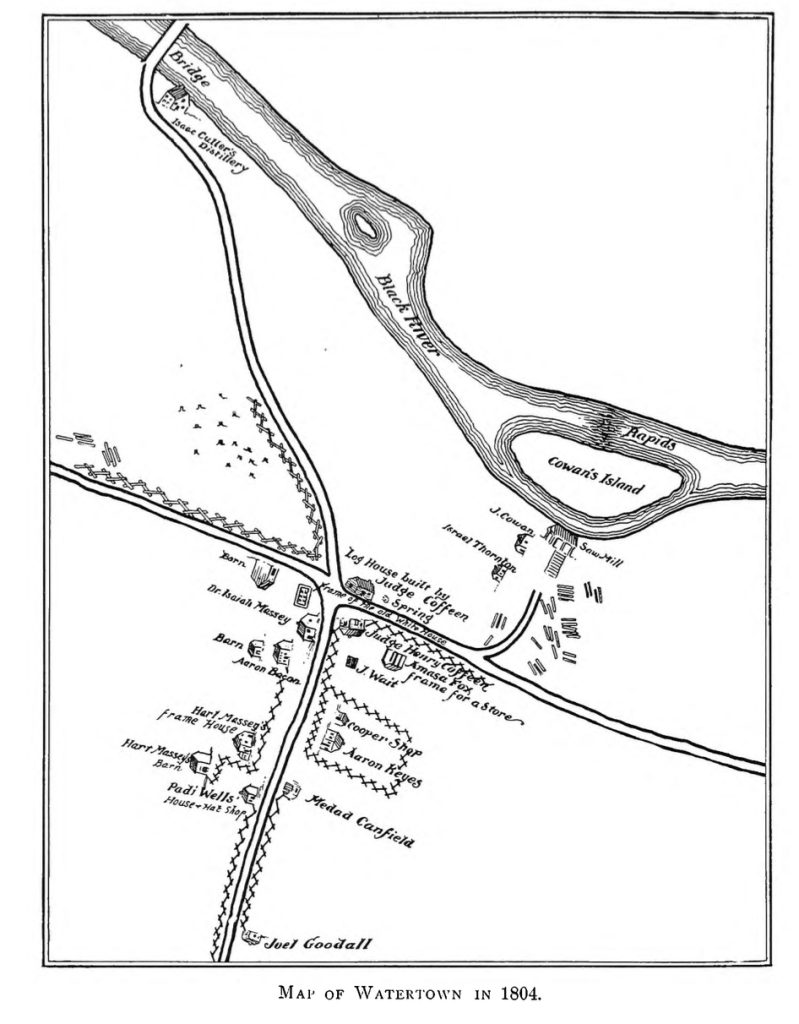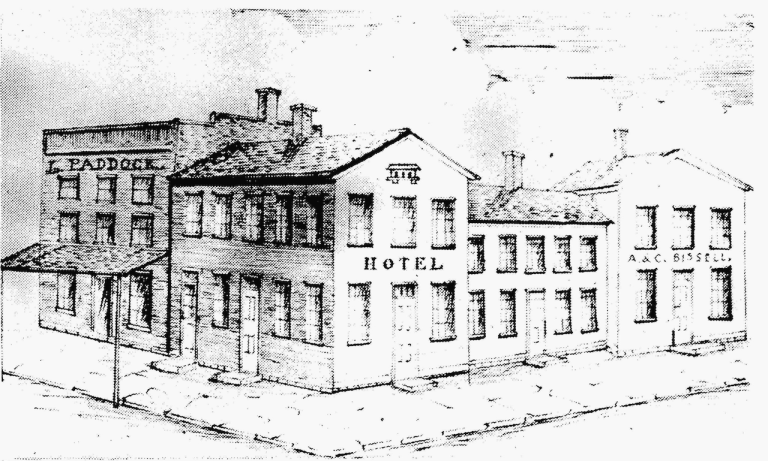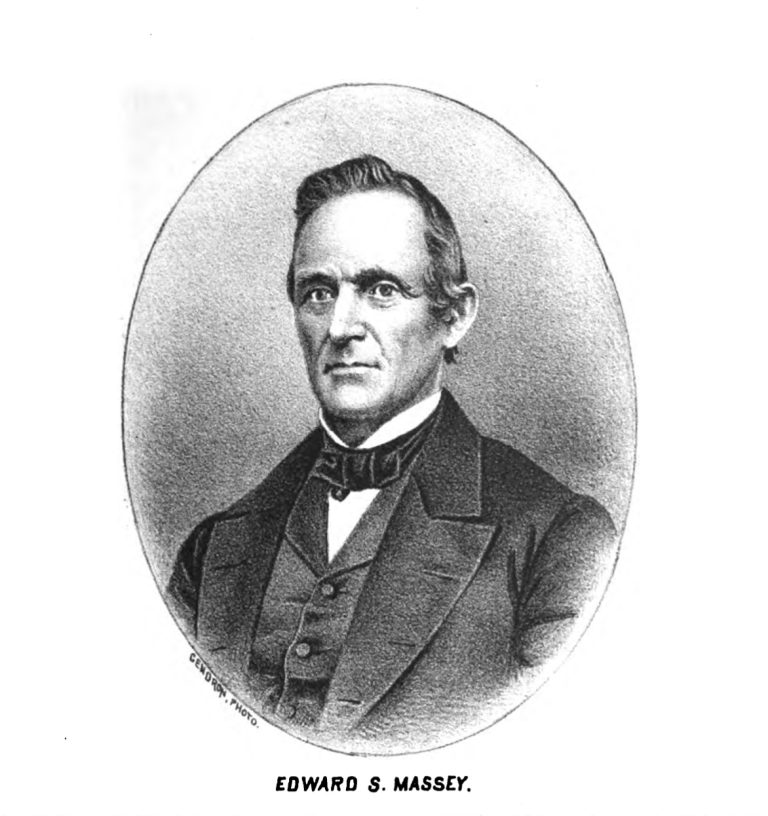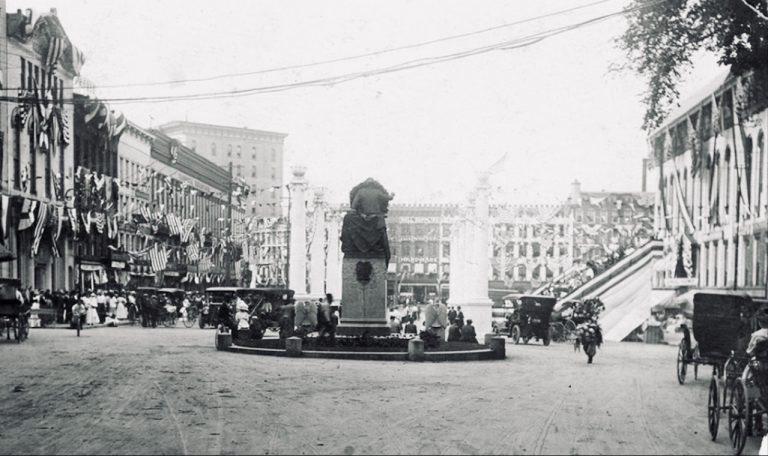Early Watertown – Its Rapid Growth from 1804 to 1812
The following is the complete, transcribed article from the Watertown Daily Times, February 22, 1892 edition, discussing early Watertown’s rapid growth from 1804 to 1812. This is actually labeled Part II in the newspaper; unfortunately, the first and any subsequent in this series could not be located. The latter half of the article details the map from 1812, street by street, dwelling by dwelling, where information was known to its anonymous author.

After 1804 the hamlet that subsequently became the village of Watertown began to attract settlers, but nevertheless there was considerable rivalry between Watertown and Burrville until the organization of the county in 1805 and the former had been designated as the county seat, after which Judge Foster and others who had located in Burrville came to Watertown to reside. Wm. Smith and John Paddock opened a store here in 1805.
A schoolhouse was erected about where the Universalist Church now stands in which the courts and supervisors held their sessions, and other buildings began to go up in various parts of the settlement. A dam was erected on the south branch of Black River at Beebee’s Island about 1804, and a second one was built a few years later by Bailey and Clark and was situated near the one belonging to the Taggarts.

Jasan Fairbanks came here from Massachusetts in 1808, and Calvin McKnight about the same time. Gordon Caswell, as has been previously stated, built a paper mill about where the Knowlton paper mill stand, in 1807. Marius W. Gilbert and Egbert Ten Eyck were likewise among the early settlers. Mr. Ten Eyck was at one time first judge of the county, and selected to legislature in 1812, and in 1824 he was elected to Congress. Joshua Beals was an early comer and was one of the side judges.
Orville Hungerford must have taken up his residence in Watertown before 1812. It is not unlikely that he came here with Judge Foster, for he was a clerk in that gentleman’s store while in Burrville. David W. Bucklin, a lawyer of ability, was admitted to practice in 1811. Samuel C. Kanady was a prominent lawyer and surveyor, and opened one of the first law offices in the county. He was afterwards agent of LeRay in the sale of his lands. Daniel Brainard, father of the late O. V. Brainard, came here from Oneida County in 1805, and engaged in the practice of medicine. He married a sister of Orville Hungerford (Lorraine) and died in 1810.

Paul Hutchinson was admitted to the practice of medicine in 1809 and became one of the physicians of Watertown. In the same year Doctor Amasa Trowbridge became his partner and he spent the remainder of his life in Watertown. He was one of the most eminent surgeons of his time.
Samuel Whittlesey came here in 1807, was a lawyer by profession, and district attorney of the district composed of Jefferson, St. Lawrence, and Lewis Counties from 1811 to 1813.

Jonathan Cowan’s grist mill in Watertown went into operation in 1805. Henry Coffeen and Andrew Edmunds are said to have built the bridge at the foot of Court Street in 1803. Two years later a damn was built below the bridge and one or more saw mills put in operation on the north side of the river, one of them having been erected by R. and T. Potter. Shortly after a grist mill was added by Seth Bailey and Gersham Tuttle.
For its public square, Watertown appears to be indebted to Jonathan Cowan, Henry Coffeen, Zachariah Butterfield, Jesse Doolittle, Medad Canfield, Aaron Keyes, Hart and Isaiah Massey, who owned adjoining property. A monument should be erected to their memory and possibly may be at some future period. Washington Street was made the broad street that it is by some of the same parties, and Mr. Coffeen, not to be outdone by the above named gentlemen, had a wide street laid out in front of his premises which he styled Madison Street.

It has been stated that Mr. Coffeen proposed to donate the piece of land between Court and Coffeen Streets, fronting the old court-house, to the village for a park, but as the offer was not promptly accepted, the proposition was withdrawn and the land put in the market and soon covered with buildings as it is now. This at least is true: the late George W. Flower, when mayor of Watertown, suggested the purchase of this ground by the city and the removal of the buildings with the view of converting it into a public park, but the council did not second the idea and the thing was dropped.
The town is said to have contained seventy or eighty families in 1804. If so its growth must have been phenomenal.

It is the purpose of these papers to name as far as possible all the persons concerned in the settlement of Watertown and making it the live town it has been from the outset, and so it may be stated that Isaac Thornton was among the first settlers and was killed by the falling of a tree. Chauncey Calhoun likewise came early. He was a brother-in-law of John Paddock, and probably arrived about the time that gentleman did. He was carpenter by trade and once owned the property where the Universalist Church stands. There was also a person of the name of Benjamin Green at the Center, and another named Dayton, but nothing more is known of him.
A map in possession of the Times made in 1812, some eight years later than the one recently noticed, shows a good degree of progress in the then village of Watertown. In the meantime the county of Jefferson had been organized, Watertown being made the county seat after an animated struggle with the village of Brownville. As a sort of compromise the county buildings were located upon the bluff at the head of Massey Street (then called Madison.)

The first court-house was built upon a spot east of the present jail and midway in the street that now runs from Coffeen to Court St. The architect was Wm. Smith. The location of the county buildings upon that site had a tendency to advance the growth of the vicinity of the court-house was rapidly built up. The map also shows that the village had enjoyed something of a “boom.” Streets had been laid out, a considerable number of dwellings, blocks and mills had been constructed, and the general appearance of the village had changed entirely.
A newspaper had been started, (this was in 1809), and had some one possessed sufficient forethought to have preserved files of the same, he would have rendered a greater service to the historian of Watertown than can be imagined. But so far known there is not a copy in existence, and there is nothing to show just when it was started.

However, it lasted several years, and until the materials were levied upon by the sheriff—perhaps because its publisher found that he had more creditors than subscribers—when one of the Abbeys happened along and purchased it, and, changing the name of the publication, ran it several years, though without taking the trouble to keep files. The paper was in existence in 1812, under the editorial charge of Jairus Rich, father of the late Henry Rich.
The streets had been planned as follows: Public Square, Washington, State, Court, Columbia (now Arsenal), Woodruff (now Franklin,) Coffeen, Mill, and Sterling Streets as they are today (as in 1892), except that Mill Street only extended from the square to the river.
Madison Street, now Massey, was laid out wide like Washington Street, and extended only from Arsenal to Coffeen Street. The street now called Lepper was laid out, but not named Main Street extended from the bridge westward, there being no streets or houses on the north side of the river east of Leray Street at the time.

The names and locations of the buildings designated on the map are as follows: At the foot of Mill Street on the bank of the south branch of Black River, Cowan’s saw mill was located. J. Cowan and Oliver Taylor owned the two dwellings on the west side of Mill Street, and Edward Cowan’s residence was the only structure on the opposite side. There were no buildings on State Street.
The only house on Woodruff Street was James O’Kelly’s dwelling, which was located about where the Central House now stands on Franklin Street. In the rear of the O’Kelly house was J. Jewett’s brick yard.
William Smith’s store was located about where the Emerich Block is, and a school-house stood upon the present site of the Universalist Church, these being the only buildings on the south side of Public Square. Perley Keyes owned a building that was situated about where the Agricultural Block stands, and further up Washington Street was one owned by Gardner White, about midway between Public Square and Sterling Street.

The only other building on that side of Washington Street was Micah Sterling’s law office, situated a few rods north of Sterling Street. Mr. Sterling’s residence was the present home of Mrs. John Clarke and was the only house or building on that street in 1812.
Capt. John Paddock’s store and dwelling were two structures on the west side of Washington Street located where the present Paddock building now stands. Proceeding up Washington Street on the west side, the next structure was A. Benedict’s building, located just south of the Jefferson County National Bank.
Judge Jabez Foster’s residence came next, and was set back a distance of about five rods from the street. Pedi Wells’ building was directly opposite Sterling’s law office and O. Pierce’s house was on a line with Judge Foster’s, about where the Herring House now stands. There were no other buildings further up the street on either side.

There were three buildings on Columba Street that occupied the present site of the American Block, but no names are given. The map also shows a row of buildings on the corner of Court Street and Public Square, but no names. The only other buildings represented on the north side of Public Square is Jesse Doolittle’s structure, which stood about where Streeter, Brimmer & Olean’s store is located.
Court Street was the principal thoroughfare in that year, and had the greater number of business blocks and dwellings. Proceeding down Court Street, from the row of unnamed buildings beginning where the Watertown National Bank now is, the first building on the north side was Caleb Smith’s. Next came an unnamed building about midway between the Crowner House and the Watertown National Bank, and S. Whittlesey’s office, which was the next building, stood about where Dr. Bell’s office is now located.

Medad Canfield’s building was just below Whittlesey’s office. In the rear of these buildings, on the brow of the bluff, were the dwellings of Chauncey Calhoun, B. Skinner, and Mr. Richardson in the order named. Just below the Crowner House and east of Arch Street were the two unnamed buildings and J. Bissel’s shop. The only other building on that side of the street, besides a peat house, was Mr. Allen’s dwelling, which was located a few rods west of Arch Street.
Beginning at the corner of Court and Arsenal Streets and proceeding down the south side of Court, was a block of unnamed buildings extending about as far as the west end of the Otis House. B. Skinner’s office stood about where the McComber & Felt building is located. Dr. Hutchinson’s building occupied the Kirby House site, Samuel Whittlesey’s dwelling was located near the old Drexel Homestead.
John Hathaway’s dwelling stood upon the corner of Jackman and Court Streets, next came Mr. Eddy’s building situated just below the Romang House. A. Wells’ building was next and the printing office of Jairus Rich stood where the Oakland House is (there was one actually located at The Oakland House.)

On the north side of Coffeen Street, next to Hathaway’s was the dwelling of a Mr. Brant, the store and dwelling of a Mr. Bixby. A building owned by Henry H. Coffeen stood near the corner of Coffeen and Massey Streets, opposite the jail, being the last building on that street. Mr. Coffeen’s dwelling stood in the centre of Massey Street, near Coffeen.
Bailey & Clark’s distillery and brewery was located directly opposite the Baron Block, and Coffeen mill and mill-house were situated just west of the thermometer works.
There were 15 buildings on Main Street extending from Court Street bridge as far west as John Helmer’s residence. On the north side of Main Street were a Mr. Hildreth’s, David Haven’s, and Josiah Farrar’s residences, the residence and office of Samuel Watson, a Mr. Wheeler’s residence and a school house.

Bailey and Clark’s mills were located where the Taggart’s Bro’s paper mill now stands, Seth Bailey’s dwelling was directly north of the mill on Main Street, and his partner, Mr. Clarke, occupied a dwelling west of him on the same side of the street. Between Mr. Bailey’s residence and the bridge there were two unnamed buildings.
The arsenal on Arsenal Street is said to have been erected in 1809, though it is not marked on the map above described. The brick for this structure were furnished by Abraham Jewett, the stone by Thaddeus Smith and Joseph Cooke, and the lime by David Stafford and Benj. Goodale.























